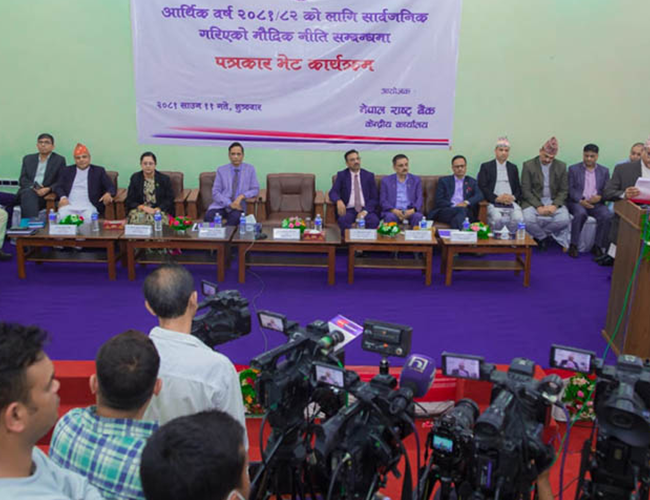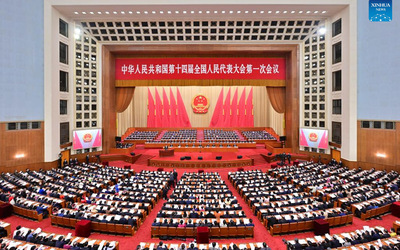
The Monetary Policy has brought some flexible provisions for managing the pressure on banks and financial institutions' capital funds. For this, the NRB has adopted the policy of encouraging the use of capital fund instruments and new instruments.
The provision of the existing 1.20 per cent credit loss that has to be made on good loans has been reduced and maintained at 1.10 per cent. Similarly, the NRB stated that the provision related to the risk weightage carried out on the purchase and sale of borrowings shall be reviewed.
It is stated that the existing limit of the Regulatory Retail Portfolio (RRP) has been increased from Rs 20 million to a maximum of Rs 25 million.
Provision has been made in which the banks and financial institutions, while calculating the 'tier-2 capital', can calculate the appropriate 'reserve amount' in the regulatory reserve as tier-2 capital, remaining under the provision of the Capital Adequacy Framework-2015, in such a manner that the total capital fund is not double that of the primary capital fund. (RSS)
Monetary Policy 081/82 Is Making The Economy More Dynamic: Governor Adhikari
Nepal Rastra Bank has announced the monetary policy for the current financial year with the aim of making the country's economy more dynamic. In the monetary policy announced by Governor Mahaprasad Adhikari on Friday, the direction of prudent and flexible monetary policy has been continued to make the economy dynamic.
"Based on the analysis of the situation, keeping in mind the comfortable price and the external sector situation, the direction of prudent and flexible monetary policy has been continued to make the economy dynamic," it is said in the monetary policy.
The monetary policy has made regulatory arrangements to maintain financial stability while emphasizing on lending to the productive sector and improving the quality of credit.
The governor official informed that the monetary policy and the regulatory policy have been aligned to facilitate credit disbursement without adversely affecting the overall economic stability.
The goal of the monetary policy is to direct liquidity management and credit flow towards the productive sector in order to help achieve an economic growth rate of 6 percent as estimated by the government in the budget of the current financial year.
Similarly, the growth rate of wide money supply is projected to be 12 percent and the growth rate of loans to the private sector will be 12.5 percent.
The Nepal Rastra Bank (NRB) has unveiled a monetary policy for the current fiscal year with a target of encouraging microfinance institutions to merge.
The monetary policy has a priority of protecting clients' interests and addressing the complaints regarding the service of such institutions.
NRB Governor Maha Prasad Adhikari said necessary regulatory arrangements would be placed in keeping the protection of clients' interests based on international good practice in priority.
The monetary policy has made arrangements of contemporary review on regulatory arrangements related to interest rates on loans and service charges taken by microfinance institutions, as well as rescheduling the loan by paying a certain per cent of interest for customers who are unable to pay their loans to the microfinance institutions due to situation.
Further arrangements would be made to encourage those microfinance institutions to work by limiting their scope of work in any certain province and place, according to the monetary policy. (RSS)
Bank rate and policy rate reduced
The bank rate of the upper limit of the interest rate corridor has been maintained from 7 percent to 6.5 percent and the policy rate from 5.5 percent to 5 percent.
Relief to builders
The monetary policy has given various concessions to the builders including extension of interest payment period till the middle of December 2081, not blacklisting them only on the basis of dishonored checks.
Ease of capital
Ease of capital fund management of banks and financial institutions through monetary policy, the existing 1.20 percent loan loss provision for good loans has been reduced to 1.10 percent. Similarly, the regulatory retail portfolio (RRP) limit has been increased from Rs 20 million to Rs 25 million.
Revision of Current Capital Lending Guidelines
It is mentioned in the monetary policy that the current capital loan guidance will be amended to extend the time period for adjusting the loan through 'variance analysis' and to apply from 1st July 2082 and to review the limit of Rs 1 crore for micro, domestic, small and medium enterprises.
Institutional share mortgage loan limit removed
For institutional investors, the existing maximum limit of Rs. 200 million for the loan provided by banks and financial institutions in the form of margin securities has been abolished. The personal limit of 15 crores has been kept unchanged.
Loan classification
When the non-performing loans have been regularized, the system that can be classified into the good category only after six months has been modified and classified into the micro-monitored category for six months, and the system has been introduced to classify the loans into the good category only after that period.
Unsecured loan
The monetary policy has also included the provision of unsecured loans for foreign employment in the budget of the current financial year.
Similarly, the National Bank has also taken a policy to facilitate loans to the agriculture and innovation sector.
Legislation
Issues such as drafting the Asset Management Act and submitting it to the government and preparing artificial intelligence (AI) guidance are included in the monetary policy.
Cooperative and microfinance sector management
In order to solve the problems in savings and credit cooperatives, the monetary policy states that the National Bank will support the implementation of the system of refunding the amount of up to Rs.
Rastra Bank has also said that it will coordinate with the Government of Nepal to formulate the necessary laws for the construction of a separate mechanism for the regulation and supervision of savings and credit cooperatives. Similarly, arrangements have been made to merge microfinance institutions, reschedule loans and revise service fees, and pay more attention to customer complaint management.
import relaxation
The existing limit of the facility available when importing goods through draft and TT has been increased from USD 35,000 to USD 50,000. Similarly, the existing limit that can be imported through Document Against Payment and Document Against Acceptance has been increased from USD 60,000 to USD 100,000. With these arrangements, it can be assumed that the import of goods will increase somewhat.
The payment limit from dollar account will be increased
It is mentioned in the monetary policy that the limit that can be spent from convertible foreign currency accounts opened in Nepal will be increased. Similarly, the National Bank has also taken a policy to facilitate the existing arrangements related to foreign currency exchange facilities available through passports. It is said that the existing list of foreign currencies that can be exchanged to facilitate activities such as remittance flow, visit, trade etc. will be reviewed.
Reform the payment system
It is mentioned in the monetary policy that the infrastructure and institutional structure necessary to fully operationalize the National Payment Switch. Similarly, organizations dealing with payment, clearing and settlement will be made public limited companies.
Emphasis on credit expansion
For the current financial year 2081/82, it is mentioned in the monetary policy that the liquidity management and credit disbursement will be directed towards the productive sector in order to help achieve the economic growth of six percent.
For the current financial year, the growth rate of detailed money supply will be 12 percent and the growth rate of loans to the private sector will be 12.5 percent, the National Bank has predicted.
No blacklisting if check bounces
The National Bank has adopted a policy of revising the existing credit information and blacklisting instructions to amend the rules of blacklisting based on dishonor of checks and restricting banking transactions.
In the same way, if the institution invested by private equity and venture capital is not able to repay the loan due to any reason and is blacklisted, it is mentioned in the monetary policy that the private equity and venture capital that invests will not be blacklisted.
Bonds will be counted as sector loans
The monetary policy of the current financial year has provided that energy-related bonds can be counted as sectoral loans. In order to increase investment in the energy sector, it is mentioned in the monetary policy that the investment made in energy related bonds including energy bonds issued by the specialized organizations related to the energy sector should be invested in the energy sector and can be calculated within the specified limits.
- The PROYEL Project Engages LGBTQIA+ at the Local Level
- Dec 26, 2024
- Resumption Of Partial Power Production From Upper Tamakoshi Gives Some Relief To Power Supply System
- Dec 26, 2024
- Weather Forecast: Mostly Fair In Kathmandu Valley
- Dec 26, 2024
- Golchha Group Join Hands with ENSSURE for Industry-Led Apprenticeship Program
- Dec 25, 2024
- Ambassador Of Pakistan To Nepal Abrar H. Hashmi Met With PM Of Nepal KP Sharma Oli
- Dec 25, 2024
















